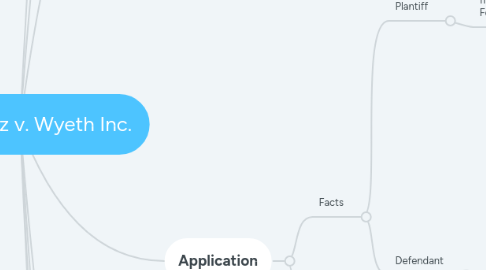
1. Facts
1.1. Parties
1.1.1. Russell Bruesewitz, et al. (Plaintiff)
1.1.2. Wyeth LLC (Defendant)
1.2. What Happened
1.2.1. The Plaintiff claimed their child (a minor) experienced a series of seizures upon receiving a dose of the Defendant's DTP vaccine.
1.3. Procedural History
1.3.1. Plantiff
1.3.1.1. Under the National Childhood Vaccine Injury Act (NCVIA) of 1986
1.3.1.1.1. a no-fault compensation program was created to allow vaccine claimants an avenue for compensation
1.3.1.1.2. a party alleging vaccine-related injury can petition the Court of Federal Claims via Health and Human Services secretary
1.3.2. Defendant
1.3.2.1. Manufacturing quid pro quo
1.3.2.1.1. enjoy significant tort-liability protections.
1.3.2.1.2. eliminates manufacturing liability for unavoidable adverse side effects.
1.3.3. Case History
1.3.3.1. 1: Plaintiff sought tort relief from vaccine manufacturer
1.3.3.1.1. 2: Defendant filed motion for summary judgement through District Court
2. Issues
2.1. Legal Question being Asked?
2.1.1. Under 42 U.S.C. § 300aa–22(b)(1) does the Plaintiff have a claim to injury from Defendant when the vaccine used by the Plaintiff causes injury and disability?
3. Rule of Law
3.1. Legal Principles
3.1.1. Decision of the court as made using precedence of previous cases, and Restatement of Torts
3.2. Legal Precedent
3.2.1. Barnhart v. Peabody Coal Co., 537 U.S. 149, 168, 123 S.Ct. 748, 154 L.Ed.2d 653
3.2.1.1. It is naive for the Court to rely on guesses as to what Congress would have wanted in legislation
3.2.1.2. not to impute to Congress one statutory objective favored by the majority of this Court at the expense of other, equally plausible, statutory objectives
3.2.2. Restatement (Second) of Torts § 402A
3.2.2.1. no reason to believe that § 300aa–22(b)(1)'s term “unavoidable” is a term of art
3.2.3. Shalala v. Whitecotton, 514 U.S. 268, 269, 115 S.Ct. 1477, 131 L.Ed.2d 374 (1995)
3.2.3.1. Supreme Court held a claimant who shows they've experienced symptoms of injury after receiving a vaccine does not make out prima facie case for compensation under the NCVI Act
4. Application
4.1. Facts
4.1.1. Plantiff
4.1.1.1. filed a vaccine-injury petition in the Court of Federal Claims
4.1.1.1.1. claiming the minor child became disabled after receiving dependent's vaccine
4.1.2. Defendant
4.1.2.1. removed the suit from the Federal District Court, who granted the Defendant summary judgment
4.1.2.1.1. holding the relevant PA laws was preempted by 42 U.S.C. § 300aa–22(b)(1)
4.1.2.1.2. National Childhood Vaccine Injury Act of 1986
4.2. Laws
4.2.1. 42 U.S.C. § 300aa–22(b)(1)
4.2.1.1. “[n]o vaccine manufacturer shall be liable in a civil action for damages arising from a vaccine-related injury or death associated with the administration of a vaccine”
4.2.2. National Childhood Vaccine Injury Act of 1986
4.2.2.1. Created a no-fault compensation program to stabilize vaccine market
4.2.2.1.1. from adverse affects of increased tort litigation
5. Conclusion
5.1. Under 42 U.S.C. § 300aa–22(b)(1) the Supreme Court held NCVI Act preempts all defect claims against vaccine manufacturers.
5.1.1. This includes potential Plaintiffs who seek compensation for injury or death that is caused by vaccine side effects.
5.1.2. Supreme Court ruled 6-2
5.1.2.1. Justice's Robert, Scalia, Kennedy, Thomas, Breyer, and Alito affirmed the lower court decision
5.1.2.2. Justice's Sotomayor, and Ginsburg filed a dissenting opinion
5.1.2.3. Justice Kegan did not participate in the case
6. Impact
6.1. (2) cited holdings
6.1.1. Holmes v. Merck & Co., Inc. 697 F.3d 1080, 1082+, 9th Cir.(Nev.)
6.1.1.1. Parents of a deceased child filed an action in the state court against a vaccine manufacturer claiming negligence, and strict product liability
6.1.1.1.1. Court of Appeals held that: NCVICA preempts all state law product liability claims of design defects and failure
6.1.2. Payne v. Tri-State Careflight, LLC
6.1.2.1. The case was a wage-and-hour dispute
7. Importance
7.1. Why a business professional would be concerned?
7.1.1. The ruling by the Supreme Court shows that under 42 U.S.C. § 300aa–22(b)(1) similar businesses are protected from increased tort liability
7.1.2. Businesses are not held liable for side-effects
7.1.3. Vaccine design (or similar product for consumers) must address the (3) parts of product liability law
8. Influence
8.1. Vaccine design is not open to question in a tort
8.1.1. Influence 1
8.1.1.1. Milik v. Secretary of Health and Human Services 121 Fed.Cl. 68, Fed.Cl.
8.1.1.1.1. Court did not need to consider objections to alternate findings, after determining the Plantiff's child's disability was not proven to be capricious
8.1.2. Influence 2
8.1.2.1. Payne v. Tri-State Careflight, LLC
8.1.2.1.1. a court must determine the scope of the preemption that Congress intended
